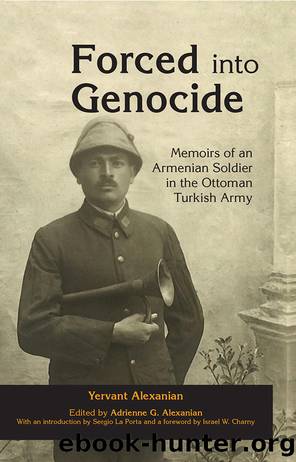Forced Into Genocide: Memoirs of an Armenian Soldier in the Ottoman Turkish Army by Adrienne G. Alexanian

Author:Adrienne G. Alexanian [Alexanian, Adrienne G.]
Language: eng
Format: epub
Tags: Political Science, General
ISBN: 9781351294829
Google: KHx_DwAAQBAJ
Goodreads: 33267275
Publisher: Routledge
Published: 2017-10-01T00:00:00+00:00
4
Deportations and Genocide
I was officially enlisted into the Ottoman Army on June 10, 1915, just weeks before my family was forcibly made to take the road of deportation. As they marched to their death, I began a new life in the workshop of the twenty-seventh Kolordu (Army Corps) of the Ottoman army. I was first sent to Dertad Baynterianâs office, who confirmed that I knew how to sew. Then, I was sent to the twenty-seventh Divisionâs Workshop.
The workshop was not built bespoke. It was the Aramian school building, which had hitherto been the only Armenian school in Sivas. The top floor was given to the cobblers, the large refectory to the tailors, and the classrooms adjacent to the refectory had been turned to bedrooms. Each âbedroomâ housed at least thirty men. The basement floors contained the loot that had been stolen from Armenian merchants all over the city, including silk and leather used in the workshop. The top floor was given to the commander of the workshop, Ethim Effendi, and his assistants, among whom were three ArmeniansâArmenak Ayvazian, the son of a government official; Armenak Dumanian, who had been the leader of the Bartevagoump scouting troupe; and a man by the name of Krikor, who eventually became completely Turkified. The supervisor of the workshop was Lieutenant Tokattsi Hamdi Chavoush, a man renowned for his visceral hatred of Armenians.
At first, when I started working at the workshop, I was mocked by many of the Armenians already there for my lack of skill. I knew most of them. The majority of them were locals from Sivas or hailed from Tokat, Marzevan, or Amasia. I quickly realized that I would not be able to meet my daily quota. Thankfully, I quickly befriended the others, and they lent me a helping hand. They would put in extra time at work just to help me meet the requirements. Within two days, I could sew a complete pair of pants, and within five days, Iâd learned to sew complete jackets, thanks to their patient mentoring. We worked with finger sewing machines that had been appropriated from an American company, and most of the textile we used had been confiscated from Armenian stores in the city. We were each expected to produce thirty-five to forty full uniforms per day. Whenever my colleagues helped me meet this quota, I would stand guard for them for a few hours every night whenever they wished to do something clandestine. The tailoring division for the workshop was directed by Haji Kheghtzi1 Jeblents Mihran, an Armenian apostate who had converted to Islam. His Turkish name was Ousda2 Ahmet. The head of my group of tailors was Varbed Nazar Odabashian, and his helpers included Yervant Khasierjian, Ohan Varbed, Melkon Chaderjian, and Tokattsi3 Hagop. Naturally, all of the Armenian tailors who had owned shops in Sivas had been forced to close shop and work for the government in exchange for scraps of food. Most of their families were later deported and killed.
Lieutenant Ethem Effendi,
Download
This site does not store any files on its server. We only index and link to content provided by other sites. Please contact the content providers to delete copyright contents if any and email us, we'll remove relevant links or contents immediately.
| Bahrain | Egypt |
| Iran | Iraq |
| Israel & Palestine | Jordan |
| Kuwait | Lebanon |
| Oman | Qatar |
| Saudi Arabia | Syria |
| Turkey | United Arab Emirates |
| Yemen |
Empire of the Sikhs by Patwant Singh(22974)
The Wind in My Hair by Masih Alinejad(5033)
Rise and Kill First by Ronen Bergman(4701)
The Templars by Dan Jones(4627)
The Rape of Nanking by Iris Chang(4136)
12 Strong by Doug Stanton(3508)
Blood and Sand by Alex Von Tunzelmann(3138)
Babylon's Ark by Lawrence Anthony(2620)
The History of Jihad: From Muhammad to ISIS by Spencer Robert(2565)
No Room for Small Dreams by Shimon Peres(2316)
The Turkish Psychedelic Explosion by Daniel Spicer(2313)
Inside the Middle East by Avi Melamed(2305)
Gideon's Spies: The Secret History of the Mossad by Gordon Thomas(2303)
Arabs by Eugene Rogan(2260)
The First Muslim The Story of Muhammad by Lesley Hazleton(2217)
Come, Tell Me How You Live by Mallowan Agatha Christie(2212)
Bus on Jaffa Road by Mike Kelly(2101)
Kabul 1841-42: Battle Story by Edmund Yorke(1985)
1453 by Roger Crowley(1956)
